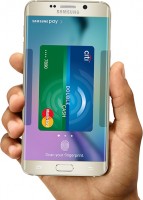Mobile wallets have struggled in the United States to win consumer adoption and usage, but worldwide the technology is growing smartly. And even in the U.S. market, it’s expected to pick up momentum. That’s according to a report issued Monday by U.K.-based Juniper Research.
The firm estimates global payments volume on mobile wallets will rise to $1.35 trillion this year, topping last year’s total of $1.02 trillion by nearly one-third. Physical goods ordered remotely via online connections will account for fully 43% of this volume, while domestic person-to-person payments will make up 39% of the value. In-store transactions using mobile wallets, while controlling just 5% of current volume, will see that share rise to 12% within five years, Juniper forecasts.

The U.S.-based big-three wallets, Android Pay, Apple Pay, and Samsung Pay, are now available in nine, 13, and eight markets worldwide, respectively, and have seen their combined global user base swell to 74 million, up from about 20 million at the end of 2015, according to Juniper’s estimates.
Juniper’s report, though, singles out PayPal Holdings Inc. as lending much of the impetus to mobile wallets. In its fourth-quarter and year-end earnings report, released last week, PayPal disclosed its mobile-payments volume reached nearly $31 billion worldwide in the quarter, up 53% over the last quarter of 2015. Accounting for much of this growth are Venmo, PayPal’s popular P2P payments service, and One Touch, a biometric authentication technology. Volume for Venmo soared 126% in the quarter, to $5.6 billion, while One Touch is now used by more than 40 million consumers and accepted by more than 5 million merchants, PayPal said.
The U.S. market, too, will soon see more growth as consumers begin to favor wallets at the point of sale for their transaction speed, following the rollout of EMV. While an EMV chip card transaction takes seven to 10 seconds, a typical Apple Pay payment takes two to three seconds, the same as a card swipe, according to Juniper. “This means that Apple Pay, and the wallets that have followed in its wake, have the opportunity to establish themselves as the contactless mechanisms of choice,” Juniper says in a white paper that summarizes its research.
One issue is availability. While most EMV terminals come with the near-field communication capability required to accept Apple Pay and the other major third-party wallets, that capability must be switched on. “A significant number [of U.S. retailers] have not yet activated the technology,” Juniper’s report says.
However, even here, progress is being made. The report says 35% of U.S. merchant locations supported Apple Pay as of late last year, up from 4% at the end of 2014, and cites head of Apple Pay Jennifer Bailey. “We believe that as contactless usage gains traction and consumers/merchants recognize the speed and convenience it offers, then, as in European markets, there will be a further and significant increase in availability at POS,” says Juniper.





